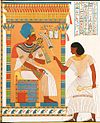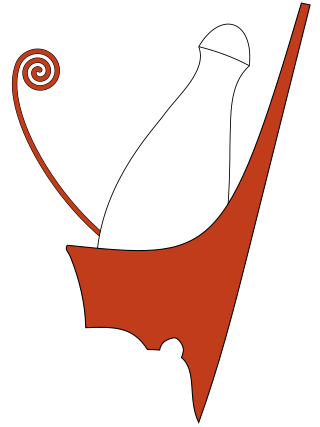
Pharaoh is the vernacular term often used for the monarchs of ancient Egypt, who ruled from the First Dynasty until the annexation of Egypt by the Roman Empire in 30 BCE. However, regardless of gender, "king" was the term used most frequently by the ancient Egyptians for their monarchs through the middle of the Eighteenth Dynasty during the New Kingdom. The earliest confirmed instances of "pharaoh" used contemporaneously for a ruler were a letter to Akhenaten or an inscription possibly referring to Thutmose III.

Horus, also known as Heru, Har, Her or Hor in Ancient Egyptian, is one of the most significant ancient Egyptian deities who served many functions, most notably as god of kingship, healing, protection, the sun and the sky. He was worshipped from at least the late prehistoric Egypt until the Ptolemaic Kingdom and Roman Egypt. Different forms of Horus are recorded in history, and these are treated as distinct gods by Egyptologists. These various forms may be different manifestations of the same multi-layered deity in which certain attributes or syncretic relationships are emphasized, not necessarily in opposition but complementary to one another, consistent with how the Ancient Egyptians viewed the multiple facets of reality. He was most often depicted as a falcon, most likely a lanner falcon or peregrine falcon, or as a man with a falcon head.
In Egyptian history, the Upper and Lower Egypt period was the final stage of prehistoric Egypt and directly preceded the unification of the realm. The conception of Egypt as the Two Lands was an example of the dualism in ancient Egyptian culture and frequently appeared in texts and imagery, including in the titles of Egyptian pharaohs.

Mut, also known as Maut and Mout, was a mother goddess worshipped in ancient Egypt. Her name means mother in the ancient Egyptian language. Mut had many different aspects and attributes that changed and evolved greatly over the thousands of years of ancient Egyptian culture.
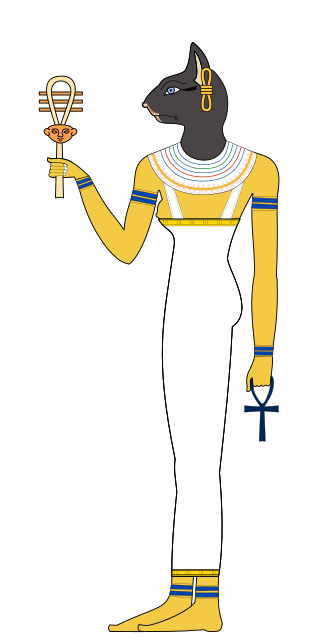
Bastet or Bast is a goddess of ancient Egyptian religion, worshipped as early as the Second Dynasty. Her name also is rendered as B'sst, Baast, Ubaste, and Baset. In ancient Greek religion, she was known as Ailuros.
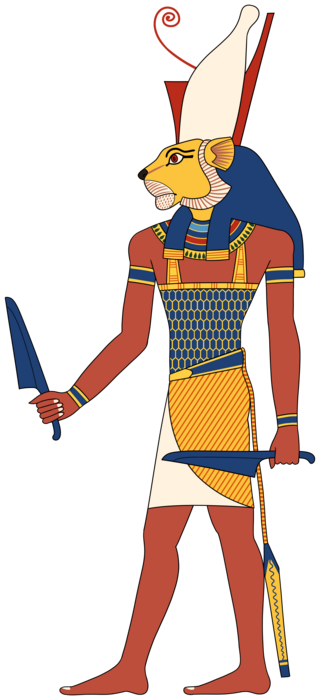
Maahes was an ancient Egyptian lion-headed god of war, whose name means "he who is true beside her". He was seen as the son of the Creator god Ptah, as well as the feline goddess whose nature he shared. Maahes was a deity associated with war, protection, and weather, as well as that of knives, lotuses, and devouring captives. His cult was centred in Taremu and Per-Bast, the cult centres of Sekhmet and Bast respectively.
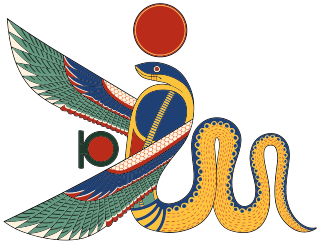
Wadjet, known to the Greek world as Uto or Buto among other renderings including Wedjat, Uadjet, and Udjo, was originally the ancient Egyptian local goddess of the city of Dep or Buto in Lower Egypt, which was an important site in prehistoric Egypt.

Buto, Bouto, Butus or Butosus was a city that the Ancient Egyptians called Per-Wadjet. It was located 95 km east of Alexandria in the Nile Delta of Egypt. What in classical times the Greeks called Buto, stood about midway between the Taly (Bolbitine) and Thermuthiac (Sebennytic) branches of the Nile, a few kilometers north of the east-west Butic River and on the southern shore of the Butic Lake.

Nekhbet is an early predynastic local goddess in Egyptian mythology, who was the patron of the city of Nekheb. Ultimately, she became the patron of Upper Egypt and one of the two patron deities for all of Ancient Egypt when it was unified.
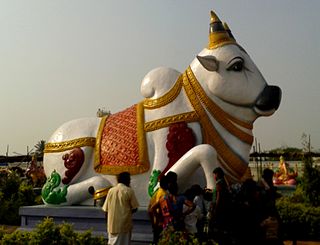
Animal worship is an umbrella term designating religious or ritual practices involving animals. This includes the worship of animal deities or animal sacrifice. An animal 'cult' is formed when a species is taken to represent a religious figure. Animal cults can be classified according to their formal features or by their symbolic content.

The Uraeus, or Ouraeus, (plural: Uraei) is the stylized, upright form of an Egyptian cobra, used as a symbol of sovereignty, royalty, deity and divine authority in ancient Egypt.

The Eye of Ra or Eye of Re, usually depicted as sun disk or right wedjat-eye, is an entity in ancient Egyptian mythology that functions as an extension of the sun god Ra's power, equated with the disk of the sun, but it often behaves as an independent goddess, a feminine counterpart to Ra and a violent force that subdues his enemies. This goddess, also known with the theonym Wedjat, can be equated with several particular deities, including Hathor, Sekhmet, Bastet, Raet-Tawy, and Mut. The eye goddess acts as mother, sibling, consort, and daughter of the sun god. She is his partner in the creative cycle in which he begets the renewed form of himself that is born at dawn. The eye's violent aspect defends Ra against the agents of disorder that threaten his rule. This dangerous aspect of the eye goddess is often represented by a lioness or by the uraeus, or cobra, a symbol of protection and royal authority. The disastrous fury and rampages of the eye goddess and the efforts of the gods to appease her are a prominent motif in Egyptian mythology.

The pschent was the double crown worn by rulers in ancient Egypt. The ancient Egyptians generally referred to it as sekhemty (sḫm.ty), the Two Powerful Ones. It combined the White Hedjet Crown of Upper Egypt and the Red Deshret Crown of Lower Egypt.
The royal titulary or royal protocol is the standard naming convention taken by the pharaohs of ancient Egypt. It symbolised worldly power and holy might, also acting as a sort of mission statement for the duration of a monarch's reign.
Gardiner's Sign List is a list of common Egyptian hieroglyphs compiled by Sir Alan Gardiner. It is considered a standard reference in the study of ancient Egyptian hieroglyphs.
The Egyptian civilization used a number of different crowns throughout its existence. Some were used to show authority, while others were used for religious ceremonies. Each crown was worn by different pharaohs or deities, and each crown had its own significance and symbolic meaning. In early Egypt, one significant and important characteristic of the many crowns, was the color white. The color symbolized kingship or nisut in the early periods and Upper Egypt. The color blue was also an important color from the 18th Dynasty on. The crowns include the Atef, the Deshret, the Hedjet, the Khepresh, the Pschent, and the Hemhem.
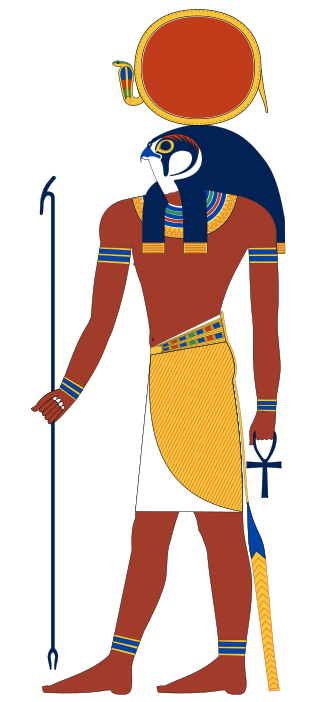
Ra or Re was the ancient Egyptian deity of the Sun. By the Fifth Dynasty, in the 25th and 24th centuries BC, he had become one of the most important gods in ancient Egyptian religion, identified primarily with the noon-day sun. Ra ruled in all parts of the created world: the sky, the Earth, and the underworld. He was believed to have ruled as the first pharaoh of Ancient Egypt. He was the god of the sun, order, kings and the sky.
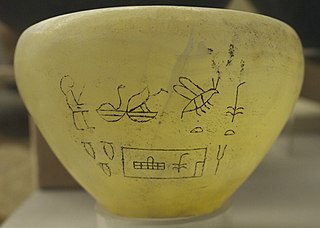
The Nebty name was one of the "great five names" used by Egyptian pharaohs. It was also one of the oldest royal titles. The modern term "Two-Ladies-name" is a simple derivation from the translation of the Egyptian word nebty.
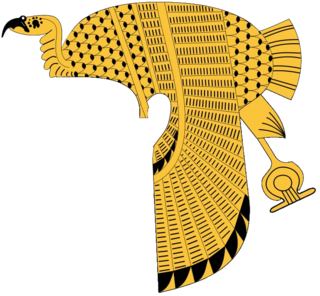
The Vulture crown was an ancient Egyptian crown worn by Great Royal Wives and female pharaohs. It was depicted as a headdress in the shape of a vulture draped over the head, with its wings hanging down on the sides. It was a symbol of protection associated with the vulture goddess Nekhbet, who often wore this crown when depicted in a human form. These crowns were frequently worn by the Great Royal Wife, high ranking priestesses, and female pharaohs. These crowns were also sometimes equipped with the Uraeus to symbolize Wadjet, representing both Upper (Nekhbet) and Lower Egypt (Wadjet).

The Regalia of the Pharaoh or Pharaoh's attributes are the symbolic objects of royalty in ancient Egypt. In use between 3150 and 30 BC, these attributes were specific to pharaohs, but also to certain gods such as Atum, Ra, Osiris and Horus. In Egyptian mythology, these powerful gods were considered the original holders of royal power and the first rulers of the Nile Valley.






















